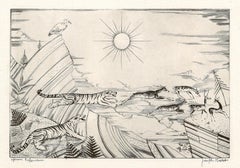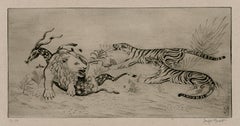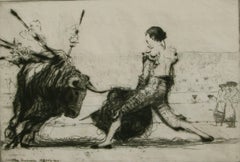Joseph Hecht Prints and Multiples
Polish artist Joseph Hecht went to live in neutral Norway at the outbreak of World War I. Immediately following the armistice, Hecht traveled to Italy; and two years later to Paris, where he maintained a studio until his death. Hecht became a member of the Salon d'Automne, thereby gaining an entrée into the Parisian art world and the opportunity to exhibit his work regularly. At his Paris studio, he taught burin-engraving, the classic copper-engraving technique, to many artists including British surrealist painter and printmaker Stanley William Hayter. In 1926 Hecht published his first suite of six prints, l'Arche de Noë, which included a preface by the French symbolist Gustave Kahn and was exhibited in December that year at the Paris gallery Le nouvel essor. Hecht’s future collaborator, mystical poet and critic André Suarès wrote a laudatory catalog article. The imagery that Hecht had developed found renewed vigor in 1928 when Suarès and Hecht collaborated on the folio, Atlas. In 1927 Hecht’s support of Hayter's printmaking explorations led to the founding of the printmaking cooperative Atelier 17, which was to become perhaps the most influential printmaking studio of the 20th century, and which endures to this day in Paris as Atelier Contrepoint. The collaborative atmosphere and experimental techniques developed at Atelier 17 influenced numerous artists including Pablo Picasso, Marc Chagall, Alberto Giacometti and Joan Miró. In 1929, Hecht also became a founding member of another group, La Jeune Gravure Contemporaine, which staged annual group shows and was influential in maintaining a vibrant interest in printmaking. Between 1926–38, Hecht's engravings were published in various collections and his work was widely exhibited, gaining him critical acclaim. Hecht won two gold medals at the 1937 Paris World's Fair.
1930s Modern Joseph Hecht Prints and Multiples
Engraving
1930s Modern Joseph Hecht Prints and Multiples
Engraving
1910s Modern Joseph Hecht Prints and Multiples
Drypoint, Etching
1960s Modern Joseph Hecht Prints and Multiples
Mezzotint
1870s Modern Joseph Hecht Prints and Multiples
Drypoint, Etching
1920s Modern Joseph Hecht Prints and Multiples
Drypoint, Etching
Early 20th Century Modern Joseph Hecht Prints and Multiples
Drypoint, Etching
1910s Modern Joseph Hecht Prints and Multiples
Drypoint
1950s American Modern Joseph Hecht Prints and Multiples
Engraving
1920s Modern Joseph Hecht Prints and Multiples
Drypoint, Etching
1920s Modern Joseph Hecht Prints and Multiples
Drypoint, Etching
Early 20th Century Modern Joseph Hecht Prints and Multiples
Drypoint, Etching
1930s Modern Joseph Hecht Prints and Multiples
Drypoint, Etching
1950s Modern Joseph Hecht Prints and Multiples
Engraving


